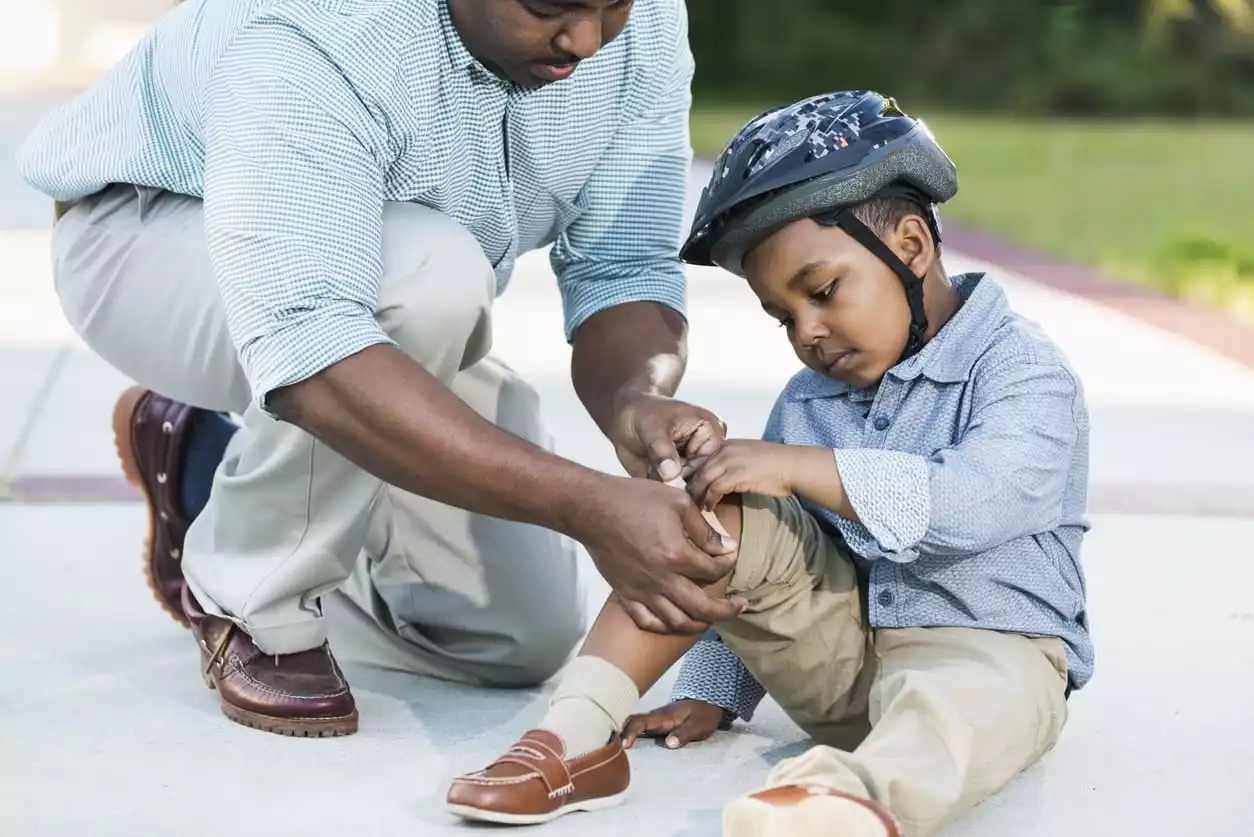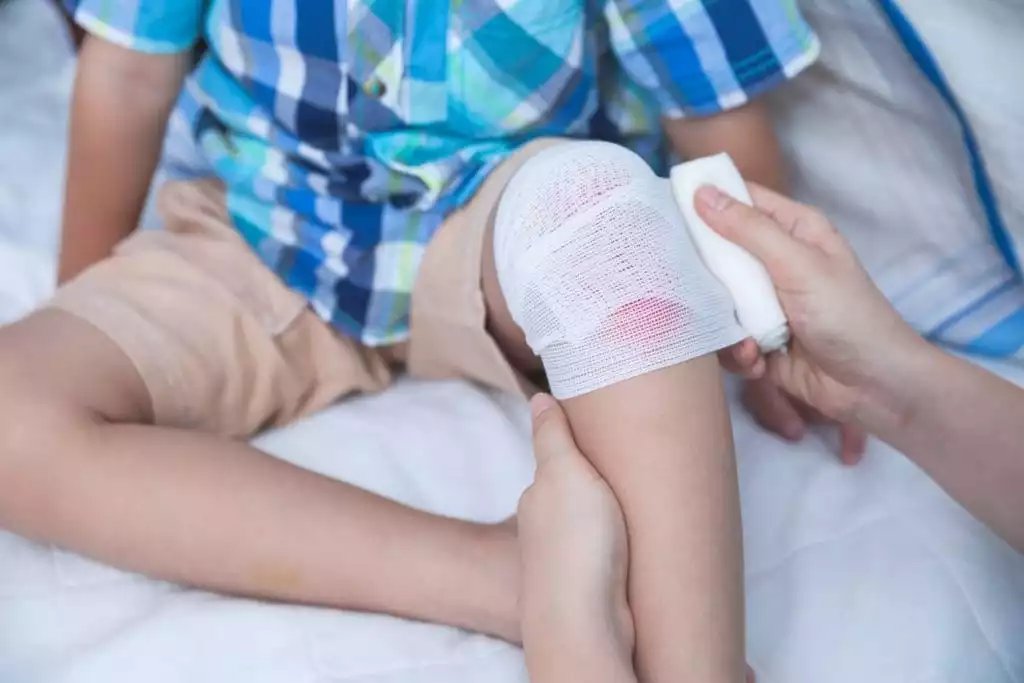
The summer months will soon be upon us, and that means kids will be running around enjoying the sun, sand, surf, and playgrounds, right from sunrise to sunset. Unfortunately, wounds, bumps and bruises come with the turf, but not every scrape warrants professional medical attention. What is most important for parents is knowing when to see the doctor, when to treat at home, and how to use basic pediatric wound care to help kids overcome those scraped knees, cuts, bruises, and sprains.
Pediatric Wound Care
Lets face it; kids are clumsy. Scrapes and scratches are bound to happen, especially when they’re out playing in the sun.
Without proper pediatric wound care, these minor injuries may turn into larger issues.
Treating children’s scrapes, cuts and lesions can be simple with these pediatric wound care tips:
- Creating a high-quality first-aid kit.
- Knowing how to avoid and treat sunburn.
- Understanding how to treat scrapes, cuts, gashes, and lesions (and when a doctor is needed).
- Knowledge of bee stings, spider bites, and other bug bites.
By the end of this guide, you’ll understand how to treat your child’s common summer injuries, and when it is best to go to do the doctor.
1. Create a Solid First-aid Kit
Pediatric wound care knowledge is essential for every parent, especially during the summer months. This knowledge starts with creating a first-aid kit.
Every home should have a first-aid kit, whether there are children present or not. You should also have kits in each of your household vehicles for when you travel.
There are pediatric wound care first-aid kits available for purchase in most local pharmacies and general stores, but you can make your own to meet your unique family needs if that better suits your lifestyle.
Art supply containers and tackle boxes are great and offer a ton of space if you need more supplies than normal.
Your first aid kit contents should include a first-aid manual as well as a list of emergency contact names and phone numbers. Common contents include:
- Scissors
- Bandages
- Tweezers
- Gauze pads
- Cold packs
- Safety pins
- Medical tape
- Alcohol wipes
- Plastic gloves
- Calamine lotion
- Antiseptic spray
- Elastic bandages
- A CPR mouthpiece
- Emergency blankets
- Splinting equipment
- Antibiotic ointment
- Fresh bottled water
- Hydrocortisone cream
- Sugar tablets (for Diabetics)
- A flashlight with extra batteries
- At least three days of non-perishable food (optional)
If you are going on vacation, make sure to place at least one full month of any necessary prescriptions in your kit, too. Even if it’s just for your home, having seven days worth of your children’s medications in your first aid kit is a smart move.
Make modifications based on your family’s unique needs. Do you have a family member with general allergies? Keep extra Benadryl in the kit. Severe allergies? Try to keep extra Epipens on hand as well. Consider any medical condition that may have a special, emergency need and include the necessary materials in your kit.
2. Avoid or Treat Sunburn
Do your best to avoid sunburn by wearing and reapplying the proper SPF at all times.
If your children have a newer wound, you need to be particularly cautious and have them wear a SPF of at least 35 at all times to avoid worsening the scarring. After about a year, the scar tissue will tan or burn the same way unscarred skin does.
Cover-ups, beach umbrellas, hats, and strollers with canopies are all great ways to protect your kids and their wounds against the sun while outside as well.
If your child does get a burn, do your best to cool it down as soon as possible. Take a quick jump in the lake, ocean, or pool, but then get out them of the sun right away. Use cool compresses made with ice water on the skin, but never put ice on sunburnt skin.
Use a sunburn cream to protect the skin, but do not use anything with a petroleum base. Non-Steroidal Anti-Inflammatories (NSAIDs) like Aleve and Ibuprofen are important for pain relief; so is hydration.
If your child has a severe burn with blistering, feels dizzy, seems confused, or has chills or a fever, it may be a sign of severe sunburn side effects. Contact a doctor or head to urgent care or the ER immediately.
3. Treating Scrapes and Gashes
Pediatric wound care usually involves treatment of scrapes, gashes, and cuts.
Whether your child has a minor knee scrape or a larger gash, start by putting on gloves to protect yourself and to keep any additional debris or bacteria from getting into the wound.
Pediatric wound care can typically be addressed on the spot. Minor scrapes should be cleaned by running them under cool water for a couple of minutes. If you aren’t home or near running water, use antiseptic spray or baby wipes until you can get to a bathroom.
Use a light coating of antibiotic cream to prevent infection and put a bandage on the wound to keep it clean and dry.
Deeper wounds with heavier bleeding take a little more time to treat. Apply pressure to the wound for 10-15 minutes and elevate the wound above the heart, if possible. Once the bleeding stops you can clean it and apply a bandage.
As a general rule, any wound that bleeds freely without showing signs of stopping for more than 10 minutes, or wounds that continuously reopen, should be addressed at urgent care or the ER.
Keep an eye on wounds as they heal. Some clear or slightly yellowish fluid is normal; this is lymph fluid produced by the body to aid in healing.
A thick yellow crust, oozing pus, increased redness or heat, or a bad odor may be signs of infection.
Call your doctor immediately if you’re concerned about your child’s wound healing improperly or if wounds just plain don’t seem to heal, even with proper care.
4. Treating Bee Stings and Bug Bites
Bug bites and bee stings aren’t usually a big deal but can definitely be painful and annoying, however it’s important to have this knowledge. If your child has a history of allergic reactions to stings, be sure to administer the appropriate treatment, whether your protocol is to take an allergy medication or use an Epipen. Seek medical attention immediately.
If your child is stung by a bee or wasp, use an index card or something flat to scrape the skin and remove the stinger without squeezing the venom sac. Gently wash the area and apply an ice pack or cold compress to help diffuse the pain.
Over-the-counter antihistamines can help with itching and acetaminophen and ibuprofen are OK for minor pain, provided that they aren’t contraindicated for your child. Always seek medical attention if you are stung in or near the mouth in case of an allergic reaction or swelling that may impact your airways.
For spider bites, wash the area carefully and apply a cook compress. Apply an antibiotic ointment and make sure your child frequently washes his hands. Seek medical attention in an emergency room immediately if you think your child was bitten by a black widow or a brown recluse. Black widows are shiny and have an orange-red hourglass shape on the belly. Brown recluse spiders are tiny and oval with a shape that looks like a violin on the back.
No matter what the cause of the sting or bite, you should continuously monitor your child for trouble breathing, wheezing, tightness in the chest, tightness in the throat, facial swelling (lips or tongue), fainting, dizziness, vomiting, or nausea. Call 911 immediately if your child develops any of these symptoms.
Conclusion
For parents, the summer months are full of fun and adventures, especially with little ones along for the ride.
You can ensure those adventures go off without a hitch by always keeping your first-aid kit stocked and your water bottles full.
Cuts, scrapes, stings, bumps, bruises, and even sprains and breaks happen, but they can be handled with just a little pediatric wound care knowledge.
Be prepared for minor injuries, but more importantly, be mentally prepared to stay calm and collected in the event an injury requires medical treatment.

 info@burtsrx.com
info@burtsrx.com

I wanted to thank you for going over some wound care tips. It’s good to know you can go to a doctor if you’re worried that your child’s wound will heal improperly. It sounds important to also go to an expert in case they can advise you on how to treat the wound over time.
thanks for the information
You are welcome, Rohit!
My son falls off of his scooter often and ends up getting different kinds of wounds here and there. We love how you talked about making sure that you make a solid first-aid kit so you can take care of any wounds that happen. We will keep these tips in mind in addition to finding a professional near us that can help my son.
Having a first-aid kit that is up-to-date and handy will allow your son to have a blast on his scooter while giving you the peace of mind knowing that you can help if anything were to happen!